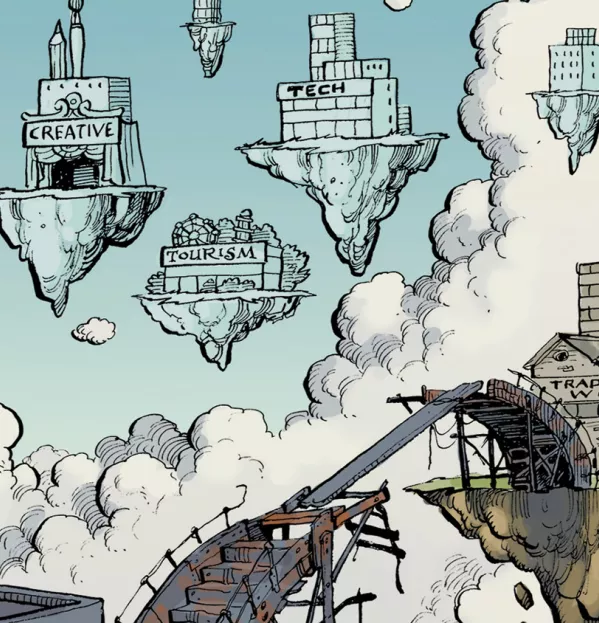One-size-fits-all schools are so 20th century...

Last month, the Resolution Foundation, a respected thinktank, reported that real wages for Millennials (those born since 1981) in the UK are 13 per cent lower than they were for Generation X - just one generation earlier. They are, by this standard, experiencing a larger drop in living standards than their peers in all other developed countries, with the exception of Greece.
For the generation still in school, employment prospects look even more precarious. There are over half a million young people aged 16-24 currently unemployed. Some regions of the country are suffering acutely. In Bradford, Middlesbrough, Swansea and Wolverhampton, more than a quarter of young people are unemployed. According to the charity Money Advice Trust, young people are accumulating debts faster than any generation before them - and more than half of adults under 25 say they worry about money.
Shrinking occupations
Walking around a school in south London just before Christmas, the deputy head told me “the number one thing I worry about is whether these kids will find valuable, meaningful work when they leave here. It is so important. It matters financially, of course, but work is also part of making them feel part of the community. Right now, even the ones getting jobs aren’t getting good jobs.”
Against the backdrop of a wobbly national economy and Brexit, teachers, schools and parents are fighting a difficult battle. What’s more, big changes are coming in: what future jobs will look and feel like is unclear. Technology, globalisation, demographic changes and urbanisation are all changing the world of work. According to Pearson, the education consortium, one in five workers is currently in an occupation that will shrink and 70 per cent of workers are in jobs with significant uncertainty about the future.
For example, the days when a student would leave school at 16, take their O levels to the nearest employer and climb the ladder are gone. Instead, 578,000 young people aged 16-30 have tried some sort of gig work: flexible and freelance, but uncertain jobs such as food delivery that often operate through zero-hours contracts.
How to start
This poses a huge challenge for educators, for whom a core objective is to prepare the young for their futures. How can we set them up for success? And what does “success” mean when the jobs around now may not be available in 2025, when current Year 7 students leave sixth form?
We should start in two areas: spatial planning and skills-based teaching.
“Spatial planning” is a fancy way of saying prepare students for jobs in their areas. The government has lots of data on jobs by region, but no one has yet used this to design curricula, designate specialist schools or match up educators and employers in specific areas.
For example, creative and digital services are booming in London, so its inner-city schools should prioritise design, coding and online services.
In the North East, however, Sunderland and Teesside has a strong cluster of businesses and universities working on manufacturing and engineering, so local students should be studying physics, chemistry and materials.
The South West’s tourism industry means employers are looking for young people to work in hotels, restaurants and people-facing roles.
Second, 18-year-olds today are likely to work for more than 10 employers before they retire, so schools need to prepare students with flexible skills.
Success stories
Pearson and Nesta have drawn particular focus on the importance of interpersonal competencies, such as social perception and the ability to give and receive instruction. The number of jobs requiring high social skills grew by 10 per cent in the US from 1980-2012.
International examples of success provide a blueprint. For example, researchers at the University of California, Berkeley, have designed a more creative science curriculum in which students work collaboratively, using multiple types of sources, to experiment, inquire and argue.
Its Seeds of Science/Roots of Reading curriculum combines hands-on experiments with readings, writings, debates and personal learning journals designed to foster deeper, more transferable learning.
The Korean government has trialled a Free Semester Program, in which 13-year-olds are given large blocks of time to design their own extracurricular activities, collaborative learning projects and creative performances. One student described the initiative as an “oasis with cool water in the desert”.
Rebuilding the bridge from education to employment will be neither quick nor easy. But it is essential.
The one thing students, parents, teachers, schools and policymakers all want is for the next generation to leave school ready to live full and productive lives in their communities. Having a good job is at the core of that. If we think creatively, with reforms such as spatial planning or skills-based teaching, hopefully we can achieve it.
Benjamin Clayton is a Fellow at Harvard’s Kennedy School of Government. He was previously chief of staff at the UK government’s National Infrastructure Commission
You need a Tes subscription to read this article
Subscribe now to read this article and get other subscriber-only content:
- Unlimited access to all Tes magazine content
- Exclusive subscriber-only stories
- Award-winning email newsletters
Already a subscriber? Log in
You need a subscription to read this article
Subscribe now to read this article and get other subscriber-only content, including:
- Unlimited access to all Tes magazine content
- Exclusive subscriber-only stories
- Award-winning email newsletters